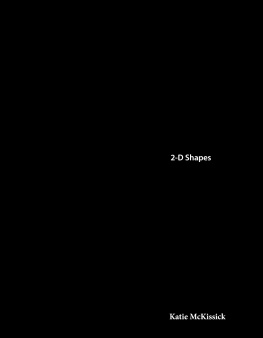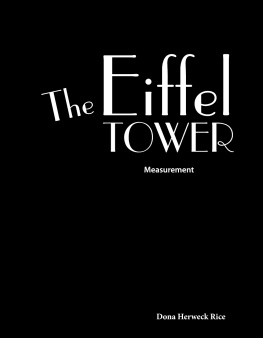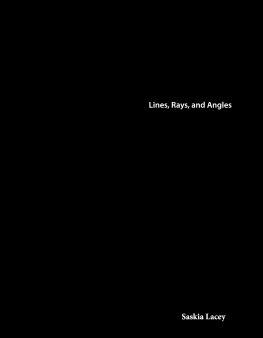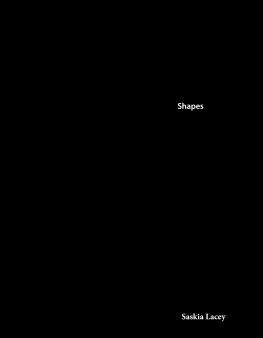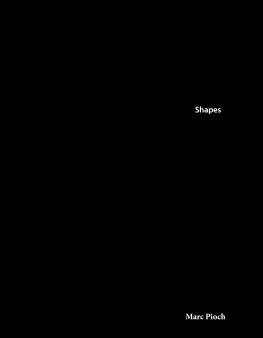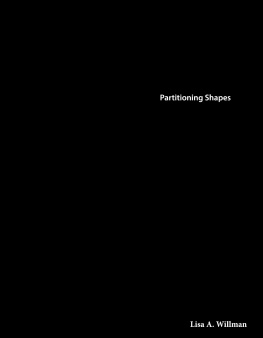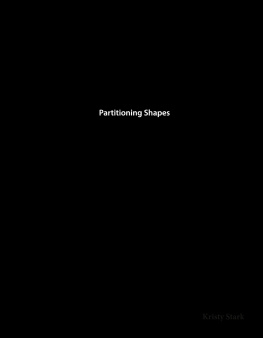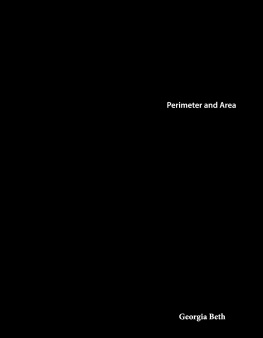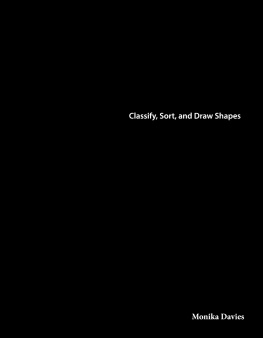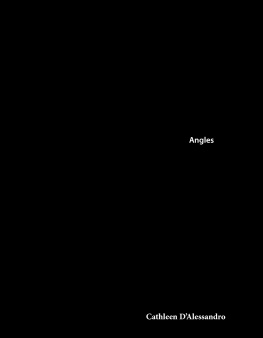Katie McKissick - Art and Culture: American Indian Artifacts: 2-D Shapes
Here you can read online Katie McKissick - Art and Culture: American Indian Artifacts: 2-D Shapes full text of the book (entire story) in english for free. Download pdf and epub, get meaning, cover and reviews about this ebook. year: 2018, publisher: Teacher Created Materials, genre: Children. Description of the work, (preface) as well as reviews are available. Best literature library LitArk.com created for fans of good reading and offers a wide selection of genres:
Romance novel
Science fiction
Adventure
Detective
Science
History
Home and family
Prose
Art
Politics
Computer
Non-fiction
Religion
Business
Children
Humor
Choose a favorite category and find really read worthwhile books. Enjoy immersion in the world of imagination, feel the emotions of the characters or learn something new for yourself, make an fascinating discovery.
- Book:Art and Culture: American Indian Artifacts: 2-D Shapes
- Author:
- Publisher:Teacher Created Materials
- Genre:
- Year:2018
- Rating:3 / 5
- Favourites:Add to favourites
- Your mark:
- 60
- 1
- 2
- 3
- 4
- 5
Art and Culture: American Indian Artifacts: 2-D Shapes: summary, description and annotation
We offer to read an annotation, description, summary or preface (depends on what the author of the book "Art and Culture: American Indian Artifacts: 2-D Shapes" wrote himself). If you haven't found the necessary information about the book — write in the comments, we will try to find it.
Art and Culture: American Indian Artifacts: 2-D Shapes — read online for free the complete book (whole text) full work
Below is the text of the book, divided by pages. System saving the place of the last page read, allows you to conveniently read the book "Art and Culture: American Indian Artifacts: 2-D Shapes" online for free, without having to search again every time where you left off. Put a bookmark, and you can go to the page where you finished reading at any time.
Font size:
Interval:
Bookmark:
0covercover.xhtmlArt and Culture AmericanIndianArtifacts 2-D Shapes Katie McKissickcover1page0001page0001.xhtmlMath Talk 1. Describe four different shapes that are quadrilaterals. How do you know each one belongs in this group of polygons? 2. How are parallel lines different from perpendicular lines? 3. What shapes can you draw that have both parallel and perpendicular sides? What shapes can you draw that have no parallel or perpendicular sides? 4. What strategies can you use to prove that an angle is, or is not, a right angle? 5. Byron says that all squares are rectangles. Lee says that all rectangles are squares. Who is correct? Explain your reasoning. 6. Look around you. What shapes do you see? How are the properties of those shapes similar? How are they different?22page0002page0002.xhtmlArt and Culture AmericanIndianArtifacts 2-D Shapes33page0003page0003.xhtml44page0004page0004.xhtmlTable of Contents Exploring the Past 4 Preserving History 7 Visiting a Museum 9 Gallery Walk 11 It's Your Turn 26 Problem Solving 28 Glossary 30 Index 31 Answer Key 3255page0005page0005.xhtmlExploring the Past The world is full of interesting people and places. Wherever you go, you can explore the culture of an area. You can study the art and architecture. You can listen to the music. You can eat the food. If you are lucky, you might even find a window into the cultures of long ago. Throughout most of the United States, the culture you find is relatively modern. It is a young country. The history of the nation goes back only a few hundred years. That is a short amount of time compared with the rest of the world. But, that does not mean the land itself is without ancient history. People were on the land long ago. Some of their cultures live on. The roots of culture throughout the Americas go deep. They thrive even today. In many ways, they are woven into the fabric of modern culture. Mogollon pottery from New Mexico, circa AD 100066page0006page0006.xhtmlpainted hide and artifacts from a Great Plains tribe77page0007page0007.xhtmlNational Museum of the American Indian in Washington, DC88page0008page0008.xhtmlPreserving History If you know where to look, you can see traces of the cultures from long ago. Art and artifacts are in museums around the country. Some, such as the National Museum of the American Indian (NMAI), are dedicated to the preservation of art and culture. They bring to life the cultures of the indigenous people of North and South America. These museums house many works of art. Some of the art is hundreds or even thousands of years old. All the pieces give us a window into the past. They show what life was like for people then. Some of those people may have stood on the very spot you stand now. The pieces tell a story of their daily lives. They tell stories, too, of ceremony and special times. They teach us about the people and their history. They make the past come alive. The Millicent Rogers Museum in New Mexico has a gallery with pottery from southwestern tribes, such as the Navajo and Pueblo.99page0009page0009.xhtmlA family tours an exhibit at NMAI in New York City.1010page0010page0010.xhtmlVisiting a Museum At most museums, there is a wealth of items to see. It can be overwhelming. It is best to pause and look at each item for a while. In this way, you can read about each piece. You can see how old the artwork is, and sometimes you can learn a little bit about the artist. Sometimes, a piece is so old that no one knows who made it. By taking a closer look, you can see tiny details the artist included in the piece. What colors and materials did the artist use? What shapes or patterns did the artist create? Looking at each piece and learning about it can take quite a long time. To take it all in, you might even want to visit again. Exhibits at museums also change often. It can be a new experience every time you go!1111page0011page0011.xhtmlA teacher and her students learn about American Indian artifacts at a museum.1212page0012page0012.xhtmlGallery Walk NMAI has one of the largest collections of artwork in the world. It is in New York and Washington, DC. The pieces at both sites span thousands of years of history. The Heard Museum in Arizona is small but also hosts a wide array of art and artifacts. The Denver Art Museum is known for its vast collection. These are just a few of the museums about American Indians in the world. There are many more, large and small. Each one does its part to keep cultures alive. Here and on the next pages, you can take a "gallery walk" through a museum. It is like taking a field trip through the pages of a book. Perhaps one day you can see these works of art in person. No matter how great a book is, it can never replace a firsthand visit! To make the most of your tour, study the images on each page. Think about the art and what it says about the culture. And, appreciate the artist's work! It took great skill to make the stunning pieces you see here. A visitor at NMAI uses a touch screen to learn more about an exhibit.1313page0013page0013.xhtmlAcoma Jar Pottery has been around for thousands of years. In the past, people used pottery for storage, cooking, and eating. People still use it for these things, but less so. Pottery is often decorative today. The Acoma tribe in New Mexico made jars from clay. They made all pieces by hand. Their pottery is well known for its geometric designs. Take a look at the details on this 100-year-old jar. There are designs in different colors. Orange and black are traditional tribal colors. Even today, Acoma artists use these colors in their art. The design is made of different shapes. These shapes form a repeating pattern. But, each row is a little bit different from the others. The bottom and top rows have squares stacked like steps. The middle row has squares, triangles, and half circles. These shapes look like small flowers. The thin, slanted lines are called a hatching pattern. This pattern stands for rain in Acoma culture. an Acoma pueblo village1414page0014page0014.xhtmlAcoma jar Let's Explore Math The artist included different types of quadrilaterals on the painted jar. Find two of the quadrilaterals. How are these two polygons similar? How are they different?1515page0015page0015.xhtmlNez Perc Bag The Nez Perc (PUHRS) tribe made all they needed from resources they found in nature. Its people often went to the Great Plains to hunt buffalo. They used the hides to make their homes and clothes. Buffalo hide is similar to leather. The women of the tribe adorned their clothes with items from nature. These included beads, cornhusks, and wool. They decorated other items, too, such as bags. A Nez Perc woman holds a similar bag in 1909.1616page0016page0016.xhtmlBags were important to people of the Plains. The ability to easily carry things was useful for this culture. The people had horses and were often on the move. A Nez Perc artist made the bag shown below. It was most likely made in the Idaho area, more than 100 years ago. The bag is decorated with an intricate pattern. Both style and function were important to the Nez Perc. Photos show that both men and women carried these bags. This one may have been used by different people to carry many needed things. Nez Perc bag1717page0017page0017.xhtmlA performer reenacts an Inka ceremony at the Festival of the Sun in Peru.1818page0018page0018.xhtmlInka Cup American Indian pottery had uses beyond the home. This is a ceremonial drinking cup called a qero. It was only used for special events and celebrations. An Inka artist made it in the 1700s. The Inka lived high in the Andes Mountains in Peru. They had a huge empire. A ceremonial cup such as this one would have been used for large events. The cup was made of wood covered in tree sap. First, the cup was carved. Then, the artist painted scenes on the outside of the cup. The artist used many colors to make the designs. The Inka often used geometric designs. The cup has many shapes as well as people painted on it. It is preserved very well. After all these years, you can still see the details. the Inka city of Machu Picchu Inka qero cup1919page0019page0019.xhtmlSioux Mask Some museums are lucky enough to have horse masks. Horses are important to the cultures of many American Indian tribes. The tribes were called the Horse Nation. The lives of the people depended on the use of their horses. Items made for horses were prized. This mask is from South Dakota. It is thought to have been made around 1900. It may have been made for a Fourth of July event. It is one of about 50 such masks that still exist. Sioux artists may have started making such masks as armor for their horses. This could have been inspired by the armor that Spanish conquistadors used. The masks are made of buffalo hide and covered in beads. The beads are used to form geometric designs and patterns. Colors help to form the patterns as well. The detail shows the respect the artist had for the horse wearing the mask.2020page0020page0020.xhtmlAn American Indian boy from South Dakota rides a horse that is wearing a decorative mask. Let's Explore Math The stars on the Lakota horse mask are made of different types of triangles. Triangles can be classified by their sides and angles. 1. Draw and name a triangle with two sides of equal length and one right angle. 2. Draw and describe a scalene obtuse triangle. 3. Is it possible to draw an equilateral triangle that includes a right triangle? Explain your reasoning.2121page0021page0021.xhtmlSioux Blanket Another piece you might see on a museum tour is a saddle blanket. This one is nearly 200 years old. It came from the Dakotas and was made by a member of the Sioux tribe. The blanket is quite large. It measures 64 inches (163 centimeters) in length. Blankets such as this one are placed on a horse's back under the saddle to protect the horse. It also provides some cushion between the rider and the horse. Everyday blankets were not as fancy, though. This one was most likely made for a special occasion. It also showed the wealth of the owner. This blanket is made from buffalo hide and wool. It is decorated with blue, black, and white glass beads. The beads make a pattern of lines and angled shapes. The pattern repeats around the edges of the blanket. A complementary pattern can be seen in the tabs at the blanket's four corners. In earlier days, artists used porcupine quills instead of beads. The design on this blanket is similar to a style that might have been made using quills. Sioux Indians sit on horseback on the Dakota plains in 1905.2222page0022page0022.xhtmlSioux saddle blanket Let's Explore Math Parallel lines never intersect, or cross. Perpendicular lines intersect to form right angles that measure 90 degrees. What types of line segments are used in the pattern on this saddle? Explain your reasoning.2323page0023page0023.xhtmlPlains Cree Saddle A saddle such as this one would have been placed on top of a saddle blanket. But, this saddle is not from the Sioux tribe. A member of the Plains Cree tribe in Canada made it. It dates back more than 100 years. Let's Explore Math The design on this saddle has triangles and quadrilaterals. There is an example of an isosceles right triangle, a square, a rectangle, a rhombus, and a parallelogram. Sort these polygons based on the properties of their sides and angles.2424page0024page0024.xhtmlThe saddle is made from hide, cotton, wool, and deer hair. It also includes glass beads, copper beads, and metal rings. Those materials were not usually used together. That makes this saddle fairly unique in its makeup. The artist would have had to work with care to get the glass, copper, and metal to fit together. In some ways, it would have been like working a puzzle. But, the artist had to create the pieces as well as the picture! It must have taken a great deal of time to make the geometric shapes that create the patterns. The design may look simple, but it is a stunning work of art. It is even more stunning when you consider the work that went into its creation. A mother and daughter from the Plains Cree tribe make beaded jewelry.2525page0025page0025.xhtmlApsalooke Case The next art piece is a case used to store a headdress. A headdress is a crown of feathers. Only the most important members of a tribe (such as the chief) wear them. They are worn at special times, such as festivals and ceremonies. This case comes from Montana. Someone in the Apsalooke (ap-SA-ah-luk-ay) tribe made it more than 120 years ago. It protected the headdress when no one was wearing it. The artist used different kinds of hide and wool cloth to form the case. Then, the case was painted. The long strips, or fringe, are made from animal hide. The case has shapes in red, green, blue, and yellow paint. Some of these shapes even join together to form new shapes. For example, in the middle of the case, two triangles join to form one square. By putting shapes in different places, an artist can create something completely new! This colorized photo from 1900 shows a Crow Indian Chief wearing a traditional headdress.2626page0026page0026.xhtmlApsalooke headdress case Let's Explore Math Sometimes, artists use simple shapes to make other shapes. What shapes make the geometric figure below? What types of line segments and angles can be seen?2727page0027page0027.xhtmlIt's Your Turn People have lived in the Americas for thousands of years. But, there is still much we do not know about the past. We can learn more and more by studying what people left behind. Throughout the Americas, the influence of American Indian tribes is strong. These tribes date back for centuries. The work they create shows artistry and skill. By studying artifacts, we can see how those tribes have changed over time. Today, artists continue to show their culture through their art. And you can be one of those artists! Try making something new. Bead a bag or make a mask for your pet. Create a pattern in fabric with natural materials you find. Who knows? Perhaps one day your work will be in a museum or a book just like this one! Navajo woven basket Navajo decorative vase2828page0028page0028.xhtmlA Pueblo boy from New Mexico crafts a dream catcher.2929page0029page0029.xhtmlProblem Solving Many artists use geometric shapes in their artwork. Sometimes these shapes form patterns. Colors can make patterns, too. Simple shapes can be combined to make other shapes. Put your own artistic talent to work! Your task is to design a blanket using a variety of colors and shapes. You may even use a repeating pattern. 1. Draw each of the following shapes in your design. You may include more shapes than those listed here. quadrilateral with at least 1 pair of parallel sides quadrilateral with at least 1 pair of perpendicular sides quadrilateral with at least 1 right angle isosceles right triangle equilateral triangle scalene obtuse triangle 2. Choose two shapes from your design. Compare and contrast their properties to show how they are similar and different.3030page0030page0030.xhtml3131page0031page0031.xhtmlGlossary ceremonial used in or done at a formal event complementary going well together equilateral describes a triangle with 3 equal sides and 3 equal angles fringe a decorative border made from hanging strips or threads geometric made up of points, lines, and shapes indigenous being born in a particular place and having a sense of belonging there intricate complex, with many parts isosceles describes a triangle with two equal sides and two equal angles parallelogram quadrilateral with opposite sides equal and parallel, and opposite angles equal patterns sequences that repeat pottery objects made out of clay and then baked at hot temperatures to harden preserved kept safe from harm quadrilaterals polygons with four sides and four angles rhombus quadrilateral with all sides equal, opposite angles equal, and opposite sides parallel right measuring exactly 90 scalene describes a triangle with no equal sides or angles tribe a group of people who share the same language, customs, and beliefs3232page0032page0032.xhtmlIndex Acoma, Americas, Apsalooke, bag, bead, blanket, buffalo, case, ceremony, cup, Denver Art Museum, The, gallery, geometric, headdress, Heard Museum, The, Inka, jar, line, mask, National Museum of the American Indian (NMAI), Plains Cree, pottery, saddle, sinew, Sioux,3333page0033page0033.xhtmlAnswer Key Let's Explore Math page 13 : Answers will vary. Possible answer : square and rectangle; similar 4 sides; 4 right angles; opposite sides equal and parallel; different square has 4 equal sides, while a rectangle has opposite equal sides page 19 : 1. Isosceles right triangle 2. 1 obtuse angle and 2 acute angles; no sides are the same length 3. No; equilateral triangles must have all angles equal, and it is impossible to draw a triangle where all 3 angles measure 90. page 21 : Parallel and perpendicular line segments; Explanations will vary, but may include that the line segments forming the sides are parallel, and the line segments forming the corners intersect at right angles. page 22 : Groups will vary. Possible answer : all sides equal square, rhombus page 25 : Shapes : rectangles, right triangles, squares, trapezoids; squares, rectangles, and right trapezoids have both parallel and perpendicular sides; right triangles have perpendicular sides; trapezoids have 1 set of parallel sides; all have right (90) angles except for the isosceles trapezoid Problem Solving 1. Designs will vary, but should include at least one example of each polygon. 2. Answers will vary. Possible answer : square and isosceles right triangle; Similar both have at least 1 right angle and at least 2 equal sides; Different a square has 4 sides and 4 angles; a triangle has 3 sides and 3 angles3434page0034page0034.xhtmlMath Talk 1. Describe four different shapes that are quadrilaterals. How do you know each one belongs in this group of polygons? 2. How are parallel lines different from perpendicular lines? 3. What shapes can you draw that have both parallel and perpendicular sides? What shapes can you draw that have no parallel or perpendicular sides? 4. What strategies can you use to prove that an angle is, or is not, a right angle? 5. Byron says that all squares are rectangles. Lee says that all rectangles are squares. Who is correct? Explain your reasoning. 6. Look around you. What shapes do you see? How are the properties of those shapes similar? How are they different?35
Next pageFont size:
Interval:
Bookmark:
Similar books «Art and Culture: American Indian Artifacts: 2-D Shapes»
Look at similar books to Art and Culture: American Indian Artifacts: 2-D Shapes. We have selected literature similar in name and meaning in the hope of providing readers with more options to find new, interesting, not yet read works.
Discussion, reviews of the book Art and Culture: American Indian Artifacts: 2-D Shapes and just readers' own opinions. Leave your comments, write what you think about the work, its meaning or the main characters. Specify what exactly you liked and what you didn't like, and why you think so.

